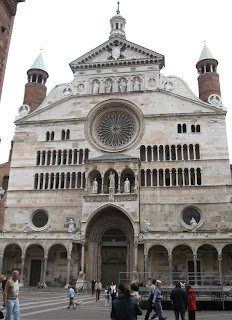Success of La Gioconda put musician on map
 |
| Amilcare Ponchielli composed 11 operas |
Ponchielli's works in general enjoyed only modest success, despite the rich musical invention for which he was later applauded. One that did win acclaim in his lifetime, however, was La Gioconda, which was first produced in 1876 and underwent several revisions but remained unaltered after 1880.
Well known for the tenor aria, Cielo e Mar, and the ballet piece, Dance of the Hours, La Gioconda is the only opera by Ponchielli still performed today and many recordings have been made, featuring some of the biggest stars of recent times.
Maria Callas, Renata Tebaldi and Montserrat Caballe are among those to have played the role of Gioconda, written for soprano, while the lead tenor part of Enzo, whose affections are sought both by Gioconda and another major character, Laura, has been taken by Giuseppe Di Stefano, Carlo Bergonzi, Luciano Pavarotti and Placido Domingo among others.
Ponchielli had such a talent for music that he won a scholarship to Milan Conservatory at nine years old and had written his first symphony by the time he was 10.
He left the Conservatory in disappointment after being denied the professorship that was supposed to have been his prize in a competition and for a number of years his main musical occupation was as a bandmaster, at first in Piacenza and then Cremona. He arranged and wrote more than 200 compositions for wind instruments.
 |
| The Milan Conservatory, which Ponchielli attended from the age of nine years |
The original premiered at the Teatro Concordia in Cremona in 1856; the revised version was first performed at the Teatro Dal Verme in Milan. The leading soprano role was taken by Teresina Brambilla, from Cassano d'Adda, just outside Milan, whom Ponchielli would marry.
Ponchielli wrote 11 operas in total but none won him the acclaim he received for La Gioconda, which was based on Angelo, Tyrant of Padua, a play by Victor Hugo.
Listen to Luciano Pavarotti performing Cielo e Mar from La Gioconda
Nonetheless, works such as Il figliuol prodigo and Marion Delorme, from another play by Victor Hugo, both performed at Teatro alla Scala in Milan, are recognised as having been influences on a new generation of composers from which Giacomo Puccini, Pietro Mascagni and Umberto Giordano emerged.
In 1881, Ponchielli was appointed maestro di cappella of Bergamo Cathedral, and from the same year he was a professor of composition at the Milan Conservatory, where his students included Puccini, Mascagni and Emilio Pizzi.
He died of pneumonia in Milan in 1886 and was buried in the city's Monumental Cemetery.
Travel tip:
Paderno Fasolaro, a small town in the heart of the Po Valley, is now known as Paderno Ponchielli in honour of its most famous native son. It was given the name after local residents began a petition on the 100th anniversary of his birth in 1934, although it took until 1950 for the President of the Republic, Luigi Einaudi, to issue a decree making the change legal.
 |
| The cathedral at Cremona is a fine example of Romanesque style |
The city of Cremona has a strong musical tradition, particularly in the production of violins and other stringed instruments. It was home to rival violin makers Antonio Stradivari, Giuseppe Guarneri and the Amati family. Cremona has an exceptional Romanesque cathedral, with an ornate facade including a Renaissance logia with three niches, flanked by two orders of loggette (small logias).
Home


